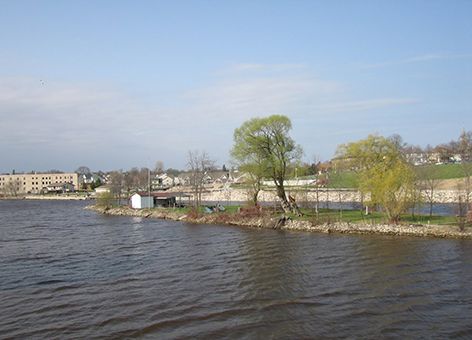Déjà vu on the Sheboygan River: Transitioning from Cleanup to Restoration in Wisconsin
MARCH 5, 2013 — One of Jessica Winter's first introductions to the problems of environmental contamination was Wisconsin's Sheboygan River. It empties into Lake Michigan, a rich recreational, commercial, and ecological area, but unfortunately, the Sheboygan has suffered from a past filled with toxic chemicals. As an intern in the U.S. Environmental Protection Agency's Great Lakes National Program Office in 2006, she visited this scenic river in eastern Wisconsin to learn about the techniques used for cleaning up the river's contaminated sediments. At the time, she didn't know she would return as an environmental scientist with NOAA's Office of Response and Restoration to work on the restorative process that follows cleanup: natural resource damage assessment.
A Superfund Site in the Making
Throughout the 20th century, industrial facilities released the hazardous chemicals polychlorinated biphenyls (PCBs), polycyclic aromatic hydrocarbons (PAHs), metals, and more into the Sheboygan River and adjacent floodplains. These chemicals have been measured at high concentrations in the river sediments and fish, limiting the public’s ability to use and enjoy the Sheboygan River for years. For example, resident fish and waterfowl from the river are unsafe to eat because the high contaminant levels exceed U.S. Department of Agriculture standards.
To address this contamination, the EPA's Superfund Division has designated the lower 14 miles of the Sheboygan River and the adjacent floodplains for cleanup. On Winter's most recent visit to the river in the fall of 2012, cleanup crews were in their final season of work on a project that has been underway for many years, beginning with emergency sediment removal in 1978. But how do you actually "clean" a polluted river like the Sheboygan? For the upstream stretch of the river, completed in 2006–2007, a crew had to suck up contaminated sediments from the riverbed, suspend them in water so they flow as slurry, and then pump the slurry through a pipeline.
Next, they pumped it into "geotubes," large porous bags that allow the river water to seep out but keep the sediment and solid pollutants inside. A wastewater treatment plant removed any remaining contamination from the water. Once the sediment was dry enough, it was transported to a specially designed hazardous waste landfill. Cleanup in the downstream stretch of the river in 2011–2012 used similar methods, as well as an excavator to scoop up some of the sediments and embedded pollutants.
Gearing up for Restoration
As this cleanup was winding down, Winter and her NOAA colleagues traveled to Sheboygan, Wis., to meet with other federal and state scientists studying the affected area. NOAA, the U.S. Fish and Wildlife Service, and the Wisconsin Department of Natural Resources serve as trustees for the public while conducting a Natural Resource Damage Assessment (NRDA). During this process, the trustees collect and evaluate data to identify the natural resources that have been injured by contamination and to quantify the resulting injuries to the environment. For example, injuries might include increased tumor rates in fish or reduced prey available for fish to eat. Luckily, the Sheboygan River is well-studied; we have data investigating animal populations and habitat quality from the 1970s to the present.

Once the trustees know precisely what the injuries are from this pollution, they work with the public to choose projects that will address those injuries. For example, this might include creating or enhancing wetlands that will provide better areas for fish to find food. Trustees then require the parties responsible for the contamination either to fund or implement these restoration projects themselves.
In 2012, this restoration process kicked off when the trustees undertook a preliminary assessment. They examined the current state of scientific information on the Sheboygan River's sediments, soils, water, invertebrates, fish, birds, mammals, and reptiles to determine whether it is reasonable to pursue a full damage assessment, which would compensate the public for the natural resources hurt by the Sheboygan's history of toxic chemicals. The preassessment screen [PDF] documents this work.
What did they conclude after the preliminary assessment? That injury to these resources was likely and that damage assessment is warranted. Next, the trustees will develop an Assessment Plan that will describe the methods that will be used to quantify damages. Trustees will invite the public to comment on the Assessment Plan. Stay tuned and check out the links below to access data and documents related to this site.
Data
- Query Manager database: This is the general informational page for Query Manager, NOAA’s database and query tool for environmental chemistry data. Follow the link to the download page to obtain the database, map, and dictionary for Great Lakes data (which includes Sheboygan River and Harbor data) and to obtain the Query Manager software for interacting with the database.
- NOAA is developing a new interface for accessing this data which will be available at ProjectDIVER.org. Project DIVER is currently a work in progress.
Documents
- Sheboygan River and Harbor Aquatic Ecological Risk Assessment volumes 1 (text), 2 (figures and tables), and 3 (appendices).
 An official website of the United States government.
An official website of the United States government. 

